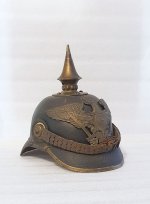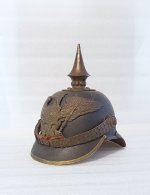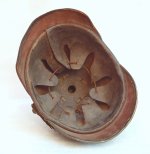Sandmann
Well-known member
Dear fellow forum members,
today I'd like to introduce my latest find, which I'm very happy about
It's a very rare and well-preserved Prussian M1867 enlisted man's helmet, which is completely original to my knowledge. I have seen Saxon, Baden, Wurttemberg and even Saxon duchy helmets on the market a few times in recent years. However, this was the first Prussian M1867 enlisted man's helmet I saw for sale with the correct type of attachment and in good condition.
It rarely happens that an item looks even better after receiving it than in the photos in the ad, but this was the case here. I'm extremely grateful to the seller for his honesty


General Informations about the helmet M1867:
Efforts were always made to reduce the weight of the infantrymen's equipment, which is why the rear spine of the M1867 helmet was eliminated. This was probably the most obvious innovation of this helmet model. Another innovation was the 10.5 cm to 11.5 cm high spike with a round spike base (diameter 8.0 cm) and which was also secured to the helmet with split pins instead of bolts. Furthermore, a round front visor and a slider mounting system for the eagle emblem. The weight saving may have been minimal, but every gram counted.
The just mentioned slider attachment with corresponding mounts on the helmet was used on the M1867 helmet only. Besides the weight saving, it was an attempt to introduce a quickly removable emblem, as the shiny eagles reflected the sunlight too much in battle, making the soldiers a good target for snipers. The idea may have made sense at first glance, but not all soldiers took good care of their equipment, what the people in charge had actually assumed. As a result, too many eagle emblems were lost in the wars of unification at the end of the 1860s and in the Franco-Prussian War of 1870/71 , which is why the old fastening method with threaded pin and squared nut was reintroduced in 1871. The rear spine was reintroduced in 1871 as well, as the wars had also shown that the M1867 helmets were no longer durable enough to withstand field use.
, which is why the old fastening method with threaded pin and squared nut was reintroduced in 1871. The rear spine was reintroduced in 1871 as well, as the wars had also shown that the M1867 helmets were no longer durable enough to withstand field use.
Also in 1867, i.e. on the helmet M1867, the cockade diameter was officially reduced for the first time (the new diameter was 5,0 cm) since the Pickelhaube was introduced. Some M1860s may have already had a smaller cockade, but this was contrary to the regulations. However, the regulation wasn't always followed, as the soldiers of the time weren't just conscientious, but also quite fashion-conscious. And too large cockades on a low helmet simply didn't look very pleasing Smaller deviations from the clothing guidelines can be found from time to time, especially for property helmets, and seem to have been tolerated.
Smaller deviations from the clothing guidelines can be found from time to time, especially for property helmets, and seem to have been tolerated.
My helmet M1867:
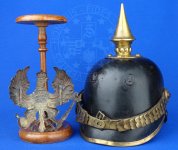
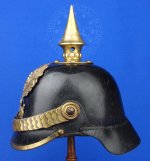
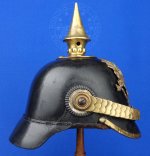
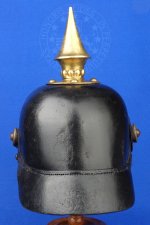
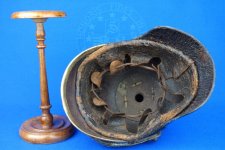
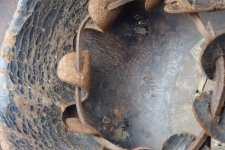
today I'd like to introduce my latest find, which I'm very happy about
It's a very rare and well-preserved Prussian M1867 enlisted man's helmet, which is completely original to my knowledge. I have seen Saxon, Baden, Wurttemberg and even Saxon duchy helmets on the market a few times in recent years. However, this was the first Prussian M1867 enlisted man's helmet I saw for sale with the correct type of attachment and in good condition.
It rarely happens that an item looks even better after receiving it than in the photos in the ad, but this was the case here. I'm extremely grateful to the seller for his honesty
General Informations about the helmet M1867:
Efforts were always made to reduce the weight of the infantrymen's equipment, which is why the rear spine of the M1867 helmet was eliminated. This was probably the most obvious innovation of this helmet model. Another innovation was the 10.5 cm to 11.5 cm high spike with a round spike base (diameter 8.0 cm) and which was also secured to the helmet with split pins instead of bolts. Furthermore, a round front visor and a slider mounting system for the eagle emblem. The weight saving may have been minimal, but every gram counted.
The just mentioned slider attachment with corresponding mounts on the helmet was used on the M1867 helmet only. Besides the weight saving, it was an attempt to introduce a quickly removable emblem, as the shiny eagles reflected the sunlight too much in battle, making the soldiers a good target for snipers. The idea may have made sense at first glance, but not all soldiers took good care of their equipment, what the people in charge had actually assumed. As a result, too many eagle emblems were lost in the wars of unification at the end of the 1860s and in the Franco-Prussian War of 1870/71
Also in 1867, i.e. on the helmet M1867, the cockade diameter was officially reduced for the first time (the new diameter was 5,0 cm) since the Pickelhaube was introduced. Some M1860s may have already had a smaller cockade, but this was contrary to the regulations. However, the regulation wasn't always followed, as the soldiers of the time weren't just conscientious, but also quite fashion-conscious. And too large cockades on a low helmet simply didn't look very pleasing
My helmet M1867:
- Helmet shell is 11.0 cm high,
- The spike is 10,5 cm high, the round spikebase has a diameter of 7,7 cm. Like the early spikes with the cruciform base the spike neck still has 2 ventilation holes only.
- The total height of this helmet with spike is 26,0 cm.
- The round front visor has a width of 4,0 cm. The width of the rear visor is 4,7 cm.
- The eagle emblem (measured with a tape measure) measures 12,0 cm (H) x 14,0 cm (W). The sliders that were soldered to the back of the eagle are 3,3 cm long
- The flat chinscales are 2,2 cm wide at the back and taper to 1,3 cm at the front.
- The rosettes have a diameter of 2,7 cm.
- The diameter of the cockade is 5,0 cm.
- The enlisted man's liner is correctly 9-lashed and made of sheepskin. Unfortunately, the upperskin of the leather is somewhat fissured due to incorrect storage, but that's ok for such an old helmet and the liner is still complete after all.
- Last but not least, the weight of the helmet is 612 g.






Last edited:

